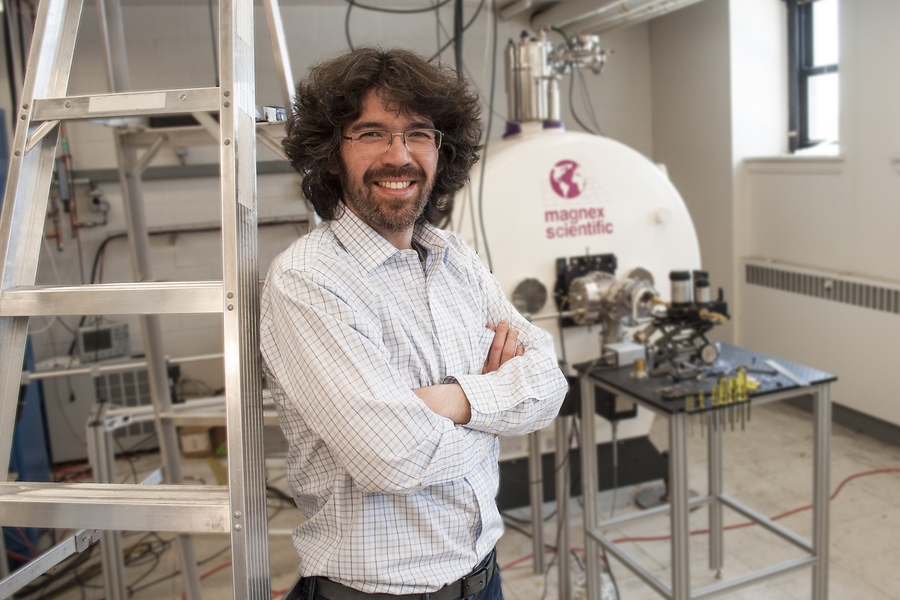MIT graduate student Alexander (Sasha) Soane received the best student paper award at last week's IEEE 18th International Vacuum Electronics Conference (IVEC), held in London. Selected from 80 students who submitted papers for consideration, Soane, a PhD candidate in the Department of Electrical Engineering and Computer Science (EECS), competed with four other finalists. He impressed five judges on the Technical Program Committee with a concise eight-minute summation of his research to win the award, which included an engraved plaque and a 500 euro check.
Soane works at MIT’s Plasma Science and Fusion Center (PSFC) on microwave sources, specifically on an amplifier for generating high-gain, high-power, and high-frequency millimeter wave radio frequency power. Using the PSFC’s gyrotron, he is trying to create a source for specific pulses of 140 GHz microwaves that will excite the electron spin system in a chemical sample in a nuclear magnetic resonance spectrometer. Soane says chemists can hope to see the signal from their spectrometer enhanced by a factor of more than 100, allowing them to acquire data faster, cutting costs, and speeding up research into protein structure.
Soane feels the judges were engaged by the engineering challenges he experienced working with 140 GHz frequencies.
“We are working with fundamentally new ideas, so we are trying to expand the biochemical science aspect of our field, while also dealing with a lot of challenging engineering constraints. Something that is straight in your CAD drawing can be a challenge to make straight in reality, under vacuum, suspended in a 5 Tesla magnetic field. All these projects have so many variables: mechanical, electromagnetic, magnetic properties — all these nobs you can tune. Digging through the data and trying to make everything comprehensible, that’s the real coup.”
Fascinated with this intersection between theory and engineering, Soane chose to pursue his graduate degree in EECS, having already spent his undergraduate years at MIT as a physics major. He was ready to apply what he had learned in his first four years to building something. He found support for his goals in the PSFC’s Plasma Science and Technology Division, headed by Richard Temkin, his thesis advisor, in collaboration with Robert Griffin, head of the PSFC’s Magnetic Resonance Division.
“I didn’t want just to prove a concept; I wanted to make things work. There is a lot of pride in figuring that out. A concept is quite elegant on paper, but the problems start mounting when you try to get from the back of the envelope to a real macroscopic device. It’s fun, and frustrating.”
Some of his frustrations with his amplifier research came from seemingly logical assumptions he and others had made. Original design work for the project focused on the specific geometry of the small cross section where the electron beam and the 140 GHz microwaves intermingle, assuming that the rest of the vacuum volume was irrelevant and would not affect measurements there. But Soane could not explain the strange frequencies he was observing in this interaction area, as their presence was counter-intuitive to the original expectations in the physics model. Later, computer simulations revealed that the vacuum chamber walls, which were thought to be too far away to have any influence, actually bounced power back into the interaction region at precisely the range of frequencies Soane had measured.
“The best thing I learned in grad school is not necessarily how to amplify 140 GHz; it’s really the ability to go back and challenge the fundamental axioms behind your entire design approach.”
As he nears completion of his thesis, and looks forward to working in the field of technical consulting, Soane reflects on how much he has changed over his decade at MIT. The satisfaction of solving undergraduate problem sets, elegant and answerable, has yielded to an appreciation for the open-ended questions that puzzle and frustrate: “When I entered grad school I didn’t understand what fundamental research really is, because I came with the undergraduate idea that a problem set has a solution. No! Sometimes you just don’t know. And that’s the reality for everyone doing any kind of research.”






